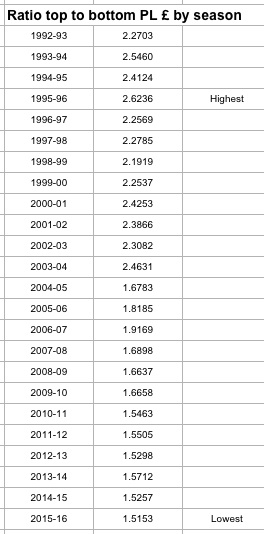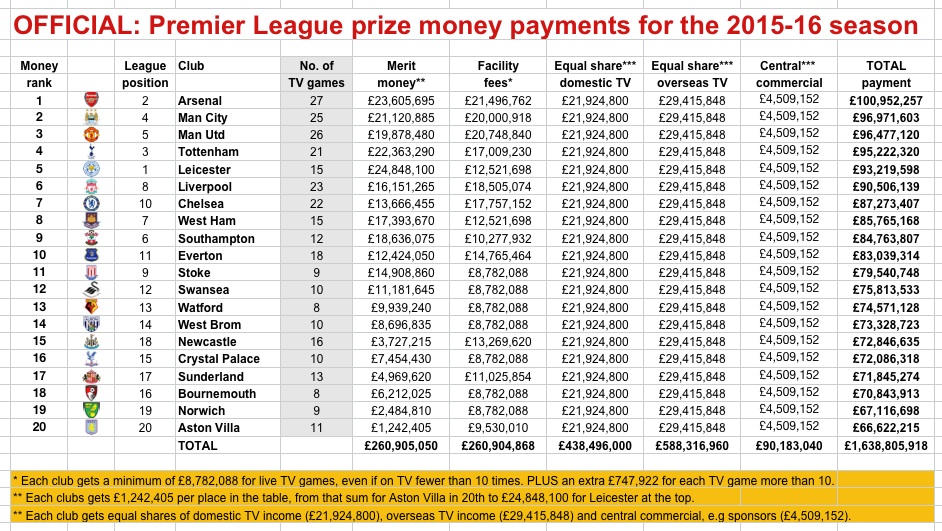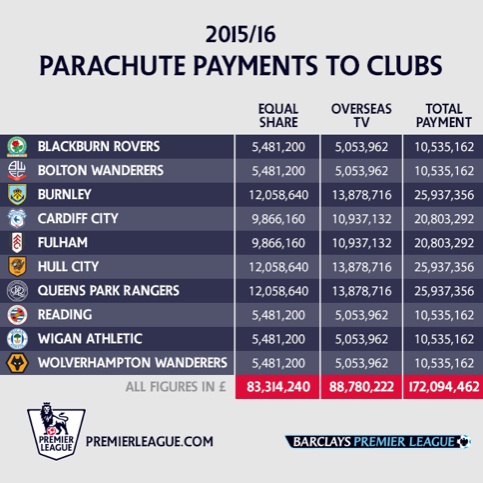By Sportingintelligence
24 May 2016
Leicester’s miraculous 5000-1 Premier League title win in 2015-16 made them globally famous but the prize money table for the season was topped by Arsenal, with official figures released today showing they have pocketed £100,952,257 from central funds alone.
The money comes primarily from the PL’s huge TV deals but also includes Arsenal’s share of the league’s central commercial income.
Manchester City were the second highest earners, making £96,971,603, followed by Manchester United (£96.5m) then Tottenham (£95.2m), with Leicester in fifth place on £93.2m. The lowest earning club, Aston Villa, earned £66.6m, the biggest sum ever for a bottom-placed club.
The money is allocated in various ways, described in more detail below – and will soar upwards again next year, also described below – but first, a summary graphic of who won what, to the nearest pound.
Article continues below
.
Arsenal’s money was made up of £23,605,000 ‘merit’ cash for finishing second in the table, £21,496,762 in ‘facility fees’ for being in so many live TV games, plus equal shares of the domestic TV deal, overseas TV deals and commercial income from the leagues sponsors, such as Barclays.
Sky and BT Sport paid £3.018 billion between them to show Premier League matches live in the UK across three seasons from 2013 to 2016 inclusive. Foreign broadcasters around world paid another £2.23 billion combined, on top, for the same period. A special feature on overseas rights from 2013 is here.
The Premier League also earns money from the sales of highlights (on Match of the Day), near-live rights, clip rights, and brings in further sums from commercial deals like the one with headline sponsor Barclays. All that cash goes into one big pot and the sums announced today are the eye-watering rewards for the clubs.
Manchester United will be the first club to earn £1bn, all-time, from the Premier League. Linked story here.
They will get bigger in future, much bigger. The domestic deals will rise from £3.018bn to £5.136bn in the three-year period from 2016-17, and the foreign deals will climb from £2.23bn to £3bn+.
For 2015-16 every club gets an ‘equal’ share of £55,849,800 derived from domestic TV income, overseas income and commercial income, with specifics in the graphic above.
Every club then gets another sum depending on league position, worth £1,242,405 per place in the table, from that sum for bottom-placed Aston Villa to £24,848,100 to winners Leicester.
Payments for 2014-15 / Payments for 2013-14 / Payments for 2012-13
Payments for 2011-12 / Payments for 2010-11 / Payments for 2009-10
Each club also gets a variable amount depending on how many times they were shown live on Sky or BT. Every club got a minimum of £8,782,088 from this pot, even if they were shown as rarely as Watford and Bournemouth (just eight live televised games each), or Norwich and Stoke (nine times each). Arsenal were shown live in the UK most, 27 times, followed by Manchester United (26) then Manchester City (25), Liverpool (23) and Chelsea (22).
Clubs have three main revenue streams: match day income (from tickets, corporate dining etcetera), media income (of which the payments listed are the largest but not the only part) and commercial income (from kit deals, sponsorship, merchandise, tours and so on).
RELATED STORY: It’s the economy, stupid! How money fuels glory in the Premier League
The ratio in central earnings between highest earners Arsenal at the top and Villa at the bottom in 2015-16 is 1.5153 to one. This is the lowest ratio in the history of the Premier League since 1992-93 and a much lower ratio – and therefore ‘fairer’ split of TV money – than occurs in Europe’s other major leagues.
In Spain’s top division, where Barcelona and Real Madrid take the lion’s share of the TV cash because they do their own deals and don’t sell rights collectively (yet), the equivalent ratio is around 8 to 1.
In Italy’s Serie A, the ratio is about 5 to 1, in France’s Ligue 1 it is about 3.5 to 1, and in the German Bundesliga it is 2 to 1. In the Champions League, the equivalent ratio between the winner and the team finishing ‘bottom’ (ie a final-stage qualifier before the group) is around 30 to 1.
The ratio split over the years in the Premier League is detailed in the small graphic to the right. Click to enlarge.
Parachute payments
The Premier League have paid ‘parachute’ payments to clubs that drop of off the top division since England’s elite division was revamped in 1992-93. They are so-called because the intention is to help them have a soft ‘landing’ at a lower level.
A complex formula is used to calculate parachute money, paid to clubs in their first few years after relegation from the top division. Burnley, Hull and QPR received £25,937,356 each for the 2015-16 season after demotion last summer, for example, while those who fell before get lesser amounts. For all parachute payments in 2015-16, see table below.
Article continues below
.
From 2016-17, clubs in their first year down will receive 55 per cent of an equal share of domestic money plus an equal share of overseas money. That is likely to be a payment of around £40m next season for Aston Villa, Norwich and Newcastle. The second year payment will be 45 per cent, or around £33m, and the third year payment 20 per cent, or around £14m.
From 2016-17 onwards, all Football League clubs will receive solidarity payments from the Premier League which amount to a percentage of the value of a Year 3 parachute payment; 30 per cent for clubs in the Championship, 4.5 per cent for clubs in League One and 3 per cent for clubs in League Two. The upshot will be they receive more than currently.
Astronomic growth
When the Premier League was formed, the new governing body had a total income in 1992-93 of £45.7m, mostly from TV rights, and it paid out a total of £37.5m in prize money that year, including parachute payments to two clubs, Notts County and Luton, who to this day have still never played in the Premier League. (They missed out on the new era by getting relegated in the final season of the old First Division).
Manchester United were top earners from central funds back in 1992-93, making £2,413,660. Middlesbrough, the lowest earners, made £1,063,135.
This season, the League’s income will be £2bn for the 2015-16 financial year, and £1.81bn has been given this season in prize money (£1.64bn) and parachute payments (£172m) combined.
Next year the League’s income will be £3bn per year, and the club finishing bottom of the Premier League will make about the same as this season’s highest earners Arsenal.
.








